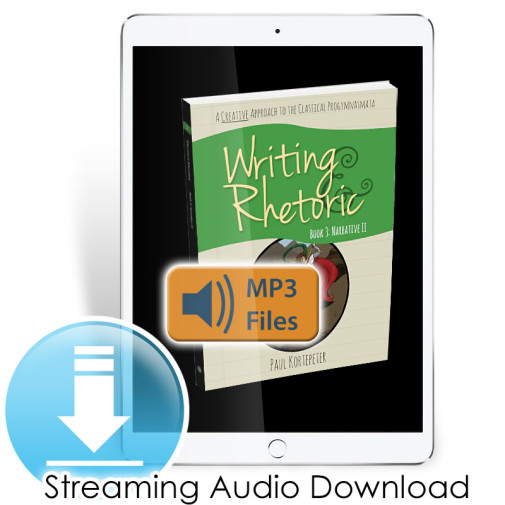We use cookies to make your experience better. To comply with the new e-Privacy directive, we need to ask for your consent to set the cookies. Learn more.
Writing & Rhetoric Book 3: Narrative II Streaming Audio Files (Digital Access)
The Narrative 2 Audio Files are optional and accompany Writing & Rhetoric Book 3: Narrative II. They feature Dr. Christopher Perrin, his wife, Christine Perrin and/or others, reading the fables, myths, historical narratives, and other source material used in the books aloud, to either add an auditory dynamic to your lesson or help auditory learners enhance their understanding of the material. Upon purchase, the access code and instructions will be emailed to you.
Customer will receive an email with access code and instructions to redeem on the Classical Academic Press website.
The Narrative 2 Audio Files accompany Writing & Rhetoric Book 3: Narrative II. These audio files allow students to engage their sense of hearing and their listening intelligence as Dr. Christopher Perrin, along with the Writing and Rhetoric series editor, Christine Perrin, deliver the historical narratives, myths, and legends aloud in a thoughtful manner.
This product is offered as a ZIP file containing several MP3 files. MP3 files can be used with most popular music players, such as iTunes.
These materials offer complete coverage of both writing and grammar.
What! Another writing program? It's easy to imagine such a question popping up since we do have a number of excellent writing programs already available. This one, however, is a worthy addition. First of all, it follows the classical model for teaching writing (and rhetoric) skills. What exactly does that mean? It means a program that is, in essence, a step-by-step apprenticeship in the art of writing and rhetoric. It's a program that believes that imitation is the foundation for learning writing and at the same time provides an easy-to-use framework for starting with models of good writing, building a "conversation in the head" (in other words, content through discussion and writing exercises), and for following the persuasive writing system developed by the ancient Romans. This system - the progymnasmata (progym, for short) - takes the student from simple retelling skills through the more and more complex skills of reporting, narrating, praising, comparison, persuasion, and defense. Modern writing borrows heavily from these skills, but the underlying methodology is distinctly different. Modern writing courses emphasize mastering the writing process and gaining experience with the different forms of writing. Accordingly, they often start with a blank sheet of paper and a brainstorming session. The progym, on the other hand, starts with well-known and excellent writing models (also known as classic literature).
Secondly, this program is user-friendly with virtually no teacher prep needed and the possibility of a minimum of teacher-student interaction (although interaction is always a plus). The publisher is the same one who has given us Latin for Children and Latin Alive! They know how to do user-friendly (and appealing). Even if you had no inkling of the meaning of a classical writing program, this would be an excellent choice. The Student Books provide instruction and examples with plenty of space to write. The Teacher Books have identical pages to the student books but add grey boxes which provide additional info, writing samples, answers and talking points. The two books are designed to be used together, and I think it would be unwise and difficult to try to use one without the other. Packages are available for most levels.
The lessons follow a pattern. The teacher reads through the text followed by a subsequent reading by the student (in upper levels, the student reads through the text examples). Narration (Tell It Back), discussion (Talk About It), and comprehension (Go Deeper) are all part of this initial look at the source material. Then starts the writing exercises (Write & Discuss). To give you an example of these, from one lesson in Book 2, copywork, dictation, sentence play, copiousness (using synonyms), and amplification (rewriting). Later in the lesson there is a time for reading/presenting the lesson's written work and separate Speak It exercises. It's suggested that this writing series would alternate with a grammar program (although no recommendations are made).
Each book is a semester's worth of writing instruction, with a total of twelve books planned. In a perfect world, a student would start in 3rd grade and complete the series in 8th grade. If your world isn't quite perfect, this series could be started anytime up to 5th or even 6th grade (in my opinion). Students beginning this program should know how to identify and create a complete sentence. It is possible to enter the program at upper levels but requires careful evaluation of the student's writing experience and the scope of the level. Some familiarity with the Progym series would also be helpful. You may wonder how this series interfaces with Common Core. The publishers note that their program "covers a host of these standards." But they further note that "while these goals are worthwhile, the Progym derive their strength from the incremental and thorough development of each form of writing. The Writing & Rhetoric series does not skip from form to form and leave the others behind, but rather builds a solid foundation of mastery by blending the forms."
Optional MP3 audio files are available. These feature Dr. Christopher Perrin, his wife, Christine Perrin and/or others, reading the fables, myths, historical narratives and other source material used in the books aloud, to either add an auditory dynamic to your lesson or help auditory learners enhance their understanding of the material. ~ Janice
Includes 11 lessons utilizing fables, historical narratives and legends. Builds on previous skills and covers fact vs. opinion, using the five W's and creating characters.
| Product Format: | Other |
|---|---|
| Brand: | Classical Academic Press |
| Grades: | 3-5 |

